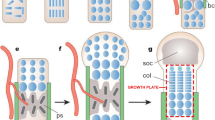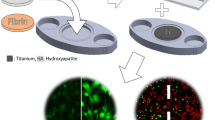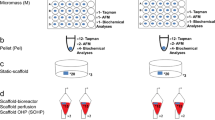Abstract
In this work, we presented a novel integrated microfluidic perfusion system to generate multiple parameter fluid flow-induced shear stresses simultaneously and investigated the effects of distinct levels of fluid flow stimulus on the responses of chondrocytes, including the changes of morphology and metabolism. Based on the electric circuit analogy, two devices were fabricated, each with four chambers to enable eight different shear stresses spanning over four orders of magnitude from 0.007 to 15.4 dyne/cm2 with computational fluid dynamics analysis. Chondrocytes subjected to shear stresses (7.5 and 15.4 dyne/cm2) for 24 h reoriented their cytoskeleton to align with the direction of flow. Meanwhile, the collagen I, collagen II and aggrecan expression of chondrocytes increased in different ranges, respectively. Furthermore, interleukin-6 as a proinflammatory cytokine can be detected at shear stress of 7.5 and 15.4 dyne/cm2 in mRNA level. These results indicated that fluid flow was beneficial for chondrocyte metabolism at interstitial levels (0.007 and 0.046 dyne/cm2), but induced an increase in fibrocartilage phenotype with increasing magnitude of stimulation. Moreover, a moderate level of flow stimulus (7.5 dyne/cm2) could also result in detrimental cytokine release. This work described a simple and versatile way to rapidly screen cell responses to fluid flow stimulus from interstitial shear stress level to pathological level, providing multi-condition fluid flow-induced microenvironment in vitro for understanding deeply chondrocyte metabolism, cartilage reconstruction and osteoarthritis etiology.





Similar content being viewed by others
References
Ateshian GA (2009) The role of interstitial fluid pressurization in articular cartilage lubrication. J Biomech 42(9):1163–1176
Beebe DJ, Mensing GA, Walker GM (2002) Physics and applications of microfluidics in biology. Annu Rev Biomed Eng 4:261–286
Bruus H (2011) Acoustofluidics 1: governing equations in microfluidics. Lab Chip 11(22):3742–3751
Bussolari SR, Dewey CF Jr, Gimbrone MA Jr (1982) Apparatus for subjecting living cells to fluid shear stress. Rev Sci Instrum 53(12):1851–1854
Chau L, Doran M, Cooper-White J (2009) A novel multishear microdevice for studying cell mechanics. Lab Chip 9(13):1897–1902
Chen T, Buckley M, Cohen I, Bonassar L, Awad H (2012) Insights into interstitial flow, shear stress, and mass transport effects on ECM heterogeneity in bioreactor-cultivated engineered cartilage hydrogels. Biomech Model Mechanobiol 11(5):689–702
Das P, Schurman DJ, Smith RL (1997) Nitric oxide and G proteins mediate the response of bovine articular chondrocytes to fluid-induced shear. J Orthop Res 15(1):87–93
El-Ali J, Sorger PK, Jensen KF (2006) Cells on chips. Nature 442(7101):403–411
Fitzgerald JB, Jin M, Grodzinsky AJ (2006) Shear and compression differentially regulate clusters of functionally related temporal transcription patterns in cartilage tissue. J Biol Chem 281(34):24095–24103
Gemmiti CV, Guldberg RE (2006) Fluid flow increases type II collagen deposition and tensile mechanical properties in bioreactor-grown tissue-engineered cartilage. Tissue Eng 12(3):469–479
Gemmiti CV, Guldberg RE (2009) Shear stress magnitude and duration modulates matrix composition and tensile mechanical properties in engineered cartilaginous tissue. Biotechnol Bioeng 104(4):809–820
Gosset M, Berenbaum F, Thirion S, Jacques C (2008) Primary culture and phenotyping of murine chondrocytes. Nat Protoc 3(8):1253–1260
Healy ZR, Lee NH, Gao X, Goldring MB, Talalay P, Kensler TW, Konstantopoulos K (2005) Divergent responses of chondrocytes and endothelial cells to shear stress: cross-talk among COX-2, the phase 2 response, and apoptosis. Proc Natl Acad Sci USA 102(39):14010–14015
Healy ZR, Zhu F, Stull JD, Konstantopoulos K (2008) Elucidation of the signaling network of COX-2 induction in sheared chondrocytes: COX-2 is induced via a Rac/MEKK1/MKK7/JNK2/c-Jun-C/EBP beta-dependent pathway. Am J Physiol Cell Physiol 294(5):C1146–C1157
Jin M, Frank EH, Quinn TM, Hunziker EB, Grodzinsky AJ (2001) Tissue shear deformation stimulates proteoglycan and protein biosynthesis in bovine cartilage explants. Arch Biochem Biophys 395(1):41–48
Khademhosseini A, Langer R, Borenstein J, Vacanti JP (2006) Microscale technologies for tissue engineering and biology. Proc Natl Acad Sci USA 103(8):2480–2487
Lee MS, Trindade MC, Ikenoue T, Goodman SB, Schurman DJ, Smith RL (2003) Regulation of nitric oxide and bcl-2 expression by shear stress in human osteoarthritic chondrocytes in vitro. J Cell Biochem 90(1):80–86
Lu H, Koo LY, Wang WM, Lauffenburger DA, Griffith LG, Jensen KF (2004) Microfluidic shear devices for quantitative analysis of cell adhesion. Anal Chem 76(18):5257–5264
Malaviya P, Nerem RM (2002) Fluid-induced shear stress stimulates chondrocyte proliferation partially mediated via TGF-beta1. Tissue Eng 8(4):581–590
Moraes C, Sun Y, Simmons CA (2011) (Micro)managing the mechanical microenvironment. Integr Biol (Camb) 3(10):959–971
Oh KW, Lee K, Ahn B, Furlani EP (2012) Design of pressure-driven microfluidic networks using electric circuit analogy. Lab Chip 12(3):515–545
Park JY, Yoo SJ, Hwang CM, Lee S-H (2009) Simultaneous generation of chemical concentration and mechanical shear stress gradients using microfluidic osmotic flow comparable to interstitial flow. Lab Chip 9(15):2194–2202
Pedersen JA, Boschetti F, Swartz MA (2007) Effects of extracellular fiber architecture on cell membrane shear stress in a 3D fibrous matrix. J Biomech 40(7):1484–1492
Rutkowski JM, Swartz MA (2007) A driving force for change: interstitial flow as a morphoregulator. Trends Cell Biol 17(1):44–50
Ryu JH, Yang S, Shin Y, Rhee J, Chun CH, Chun JS (2011) Interleukin-6 plays an essential role in hypoxia-inducible factor 2alpha-induced experimental osteoarthritic cartilage destruction in mice. Arthritis Rheum 63(9):2732–2743
Schinagl RM, Kurtis MS, Ellis KD, Chien S, Sah RL (1999) Effect of seeding duration on the strength of chondrocyte adhesion to articular cartilage. J Orthop Res 17(1):121–129
Shao J, Wu L, Wu J, Zheng Y, Zhao H, Jin Q, Zhao J (2009) Integrated microfluidic chip for endothelial cells culture and analysis exposed to a pulsatile and oscillatory shear stress. Lab Chip 9(21):3118–3125
Smith RL, Donlon BS, Gupta MK, Mohtai M, Das P, Carter DR, Cooke J, Gibbons G, Hutchinson N, Schurman DJ (1995) Effects of fluid-induced shear on articular chondrocyte morphology and metabolism in vitro. J Orthop Res 13(6):824–831
Swartz MA, Fleury ME (2007) Interstitial flow and its effects in soft tissues. Annu Rev Biomed Eng 9:229–256
Urbich C, Dernbach E, Reissner A, Vasa M, Zeiher AM, Dimmeler S (2002) Shear stress–induced endothelial cell migration involves integrin signaling via the fibronectin receptor subunits α5 and β1. Arterioscler Thromb Vasc Biol 22(1):69–75
Wang P, Zhu F, Lee NH, Konstantopoulos K (2010) Shear-induced interleukin-6 synthesis in chondrocytes: roles of E prostanoid (EP) 2 and EP3 in cAMP/protein kinase A- and PI3-K/Akt-dependent NF-kappaB activation. J Biol Chem 285(32):24793–24804
Wang L, Zhang ZL, Wdzieczak-Bakala J, Pang DW, Liu J, Chen Y (2011a) Patterning cells and shear flow conditions: convenient observation of endothelial cell remoulding, enhanced production of angiogenesis factors and drug response. Lab Chip 11(24):4235–4240
Wang P, Zhu F, Konstantopoulos K (2011b) Interleukin-6 synthesis in human chondrocytes is regulated via the antagonistic actions of prostaglandin (PG)E-2 and 15-deoxy-Delta(12,14)-PGJ(2). PLoS ONE 6(11):e27630
Wang P, Zhu F, Tong Z, Konstantopoulos K (2011c) Response of chondrocytes to shear stress: antagonistic effects of the binding partners Toll-like receptor 4 and caveolin-1. FASEB J 25(10):3401–3415
Xing Y, Gu Y, Gomes RR Jr, You J (2011) P2Y(2) receptors and GRK2 are involved in oscillatory fluid flow induced ERK1/2 responses in chondrocytes. J Orthop Res 29(6):828–833
Yeh CC, Chang HI, Chiang JK, Tsai WT, Chen LM, Wu CP, Chien S, Chen CN (2009) Regulation of plasminogen activator inhibitor 1 expression in human osteoarthritic chondrocytes by fluid shear stress: role of protein kinase Calpha. Arthritis Rheum 60(8):2350–2361
Yokota H, Goldring MB, Sun HB (2003) CITED2-mediated regulation of MMP-1 and MMP-13 in human chondrocytes under flow shear. J Biol Chem 278(47):47275–47280
Zhu F, Wang P, Kontrogianni-Konstantopoulos A, Konstantopoulos K (2010a) Prostaglandin (PG)D(2) and 15-deoxy-Delta(12,14)-PGJ(2), but not PGE(2), mediate shear-induced chondrocyte apoptosis via protein kinase A-dependent regulation of polo-like kinases. Cell Death Differ 17(8):1325–1334
Zhu F, Wang P, Lee NH, Goldring MB, Konstantopoulos K (2010b) Prolonged application of high fluid shear to chondrocytes recapitulates gene expression profiles associated with osteoarthritis. PLoS ONE 5(12):e15174
Acknowledgments
This work was supported by the National Nature Science Foundation of China (No. 81171464) and Knowledge Innovation Program of the Chinese Academy of Sciences (KJCX2-YW-H18).
Author information
Authors and Affiliations
Corresponding authors
Rights and permissions
About this article
Cite this article
Zhong, W., Ma, H., Wang, S. et al. An integrated microfluidic device for characterizing chondrocyte metabolism in response to distinct levels of fluid flow stimulus. Microfluid Nanofluid 15, 763–773 (2013). https://doi.org/10.1007/s10404-013-1186-9
Received:
Accepted:
Published:
Issue Date:
DOI: https://doi.org/10.1007/s10404-013-1186-9




